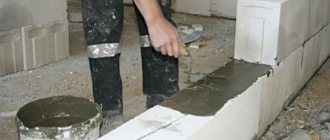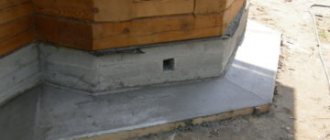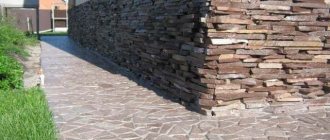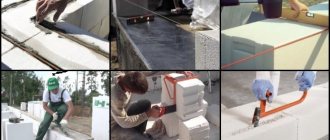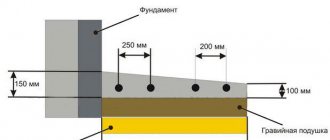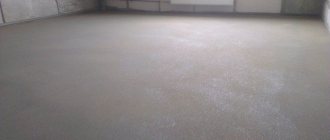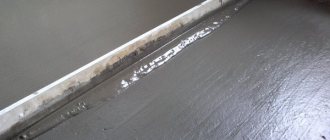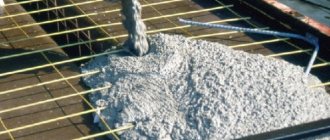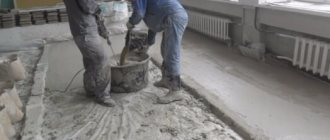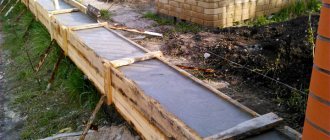How to make foundation mortar
In order to independently prepare a cement mortar for pouring the foundation, it is important to select the right components, maintain the necessary proportions of materials and take into account some of the nuances of mixing and pouring.
How to make a mortar for the foundation of a private house, proportions.
Its quality and durability depend on how correctly and in what proportions the components for the foundation mortar are selected.
Materials for the mixture.
In order to make concrete for the foundation, you will need:
Water for preparing cement mortar should, if possible, not contain chemicals (fuel oil, gasoline, etc.). Ordinary running water is what you need.
The sand should not be silty or clayey. Fatty substances create films that prevent the components from adhering to each other. Ideally, washed sand goes into the solution, the cleaner the better.
Cement is distinguished by its brand. The most common are M300, M400 and M500. The higher the grade of cement, the higher the quality of the resulting solution, that is, such technical characteristics as compressive and fracture strength.
According to the construction goals and the size of the foundation, a specific brand of cement is selected.
How to make a mortar for the foundation of a cottage proportions.
In order to prepare a solution for the foundation, you will need water, sand, cement, crushed stone, and, if necessary, various additives.
Crushed stone should not be limestone. You should also not add gravel as a filler for cement mortar. It is better to take crushed stone. Its sharp corners and uneven edges cling to each other and thereby increase the strength of the concrete for the foundation. Cement-sand, as well as mortar based on gravel, expanded clay, and other fillers will be less durable and therefore not used in the manufacture of concrete for foundations.
Additives are needed if you need to make a solution under special conditions. For example, when you need to make a solution in frosty weather, or the finished foundation will be partially or entirely in water and exposed to an aggressive environment. Additives are mixed with water according to the instructions on the package. It is worth remembering that any additives lower the grade of concrete.
Cooking methods.
There are 2 main mixing methods: mechanical (using an electric concrete mixer) and manual. Let's look at each separately.
Mechanical method.
This method involves the purchase of a rather expensive tool - an electric concrete mixer. Since pouring the foundation is usually the very beginning of construction, purchasing a concrete mixer at this stage is economically justified. So, the object should have:
Construction of a monolithic foundation proportions.
Diagram of a monolithic foundation on a sand and gravel bed
- buckets;
- shovels;
- water barrel or hose;
- concrete mixer;
- extension cord (carrying).
Buckets are convenient for carrying sand and crushed stone and loading cement into a concrete mixer. In addition, buckets make it easy to measure the required amount of each component and maintain the correct proportions. Shovels are used to throw materials into buckets.
The capacity of the concrete mixer depends on the size of the building under construction and varies between 50-300 liters. To build a private house, a single-phase 220 volt concrete mixer will be sufficient. Larger projects, as well as industrial facilities, may require 380 volt three phase. To operate the concrete mixer itself, you may need an extension cord to supply electricity to it.
All prepared components (water, cement, sand, crushed stone) in the required quantities are loaded into the concrete mixer bowl and the apparatus is turned on. The mass is brought to a homogeneous creamy state. The solution for pouring the foundation is ready.
Manual method.
To knead manually you will need:
- buckets;
- shovels and bayonets;
- capacity;
- water barrel or hose;
- hoe.
You need to pour water into the container for mixing the components (already with additives, if needed), then add sand and cement. It is convenient to mix the solution manually in a trough or old bathtub using a hoe or bayonet shovel. The mass needs to be made homogeneous, similar to sour cream. At the very end, all that remains is to add crushed gravel and mix everything again. The solution is ready.
It’s good if it is possible to pour the foundation directly from a concrete mixer or trough - this way you can save a huge amount of time and effort. If this is not possible, then the ready-made cement mortar is poured into buckets using a shovel and the foundation is poured from them.
Cement and sand are mixed in a ratio of 1:3. The amount of crushed stone is not strictly standardized, but usually they take the same amount as sand. Thus, for 1 bucket of cement there are 3 buckets of sand and 3 buckets of crushed stone.
The amount of water is selected experimentally each time, as it depends on many factors. For example, from the humidity of sand and air. It is important to achieve the desired consistency (like sour cream) and not to overdo it with water. The thinner the solution, the lower the grade, and, accordingly, the worse the strength of the resulting concrete.
Concrete does not set well at temperatures below +8 degrees Celsius (unless frost-resistant additives were included in it), so it is better not to pour in cold weather. The quality of such concrete will be worse than that of ordinary concrete, and, alas, nothing can be done about it.
The process of concrete setting has nothing to do with drying! If pouring occurs in hot, sunny, dry weather, then there is no need to add additional water to the solution. In this case, the only correct solution would be to water the foundation for several days simply from a hose, from above, to prevent the concrete from drying out. If it dries out, it begins to burst and crack.
Cement mortar proportions
First I would like to understand the types of cement mortar itself . They come in several types:
- normal;
- skinny;
- fatty.
This classification is a consequence of the different amount of liquid that is used to dilute the dry ingredients of the solution.
The greasy solution is obtained by using a small amount of water. On the one hand, the mixture sets very quickly, but on the other hand, after hardening, the mixture may crack over time, which negatively affects the life of the building.
A lean solution, on the contrary, is prepared with a large amount of water. The characteristics of the finished solution leave much to be desired, and the setting time of the mixture increases significantly.
The best option is a normal solution, in which the harmonious proportions of all components are observed - cement, sand and liquid. After hardening, such a solution does not crumble or crack, which makes construction projects quite durable.
Proportions
The most common solution is a combination of cement and sand (1:3). Do you want to know how to mix such a solution? There is nothing complicated about this. Taking three parts of sand, mix them with one part of cement in a separate container.
Mix thoroughly until the dry mixture becomes the same shade . Then you can start adding water while stirring the mixture using a shovel or electric drill with an attachment.
Preparation of the solution
The finished solution should resemble thick sour cream in consistency, so after mixing the dry ingredients, add water in small portions. On average, the volume of liquid leaves half the volume of cement, but this is an approximate proportion.
It is also worth noting the fact that the brand of ready-made cement mortar and the brand of cement are different concepts.
The grade of mortar is the grade of cement divided by the volume of filler used, i.e. sand
So, to mix the M100 brand solution we will need the following components:
- cement grade M300;
- three buckets of sand.
But this does not mean that M100 grade cement mortar is prepared only from M300 grade cement.
M300
If M400 cement is available, then to prepare the solution you will need four buckets of sand (ratio 1 to 4). If the cement is M500, then five buckets (ratio 1 to 5), etc.
We have already said that cement mortar is used for a wide variety of construction purposes. Accordingly, the proportions of sand and cement , as well as other components of the solution, will be different for each of the specific areas of application. Let's look at each of them in more detail.
How to knead for the foundation
The foundation is a defining moment in the construction of any construction project, on which the operational life directly depends. That is why it is very important to strictly observe the proportions of the foundation solution.
For the foundation
A high-quality foundation should consist not only of traditional mortar components - sand, cement and water, but also crushed stone. It should not be limestone, because this does not increase the strength of the finished solution. Also, do not replace crushed stone with expanded clay, gravel and other similar materials.
In most cases, cement grades M400 and M500 are used to make the foundation. Strength is extremely important for the foundation of a building, so the use of high grades of cement is fully justified.
M500
As for sand and water, the requirements are absolutely identical to those for ordinary cement mortar used for plastering walls, laying bricks, etc. Water should not contain impurities, oils or foreign objects.
Bathroom wall panels are quite easy to install, they are quite durable, can easily cope with temperature changes and have a long service life. It's all about this wonderful material.
With the help of a self-leveling floor screed, you can minimize all the difficulties of floor leveling. Here you can learn about the different types and costs of self-leveling screed.
Quarry sand has become widespread due to its low cost and excellent natural qualities. By clicking on the link, you will become familiar with the technical characteristics of this material.
The sand must be washed and sifted so that there are no traces of clay, stones, silt formations, etc.
The proportions of sand and cement for preparing mortar for the foundation are as follows - three buckets of sand are taken for one bucket of cement.
As for crushed stone, in most cases it is identical to the amount of sand. If you measure everything in buckets, then for one bucket of M400 or M500 cement you will need three buckets of crushed stone and three buckets of sand.
Crushed stone
Water must be diluted carefully so as not to make the solution too liquid. It is very important here how dry the sand we have is available, i.e. if it is wet, it is advisable to dry it before mixing with the rest of the ingredients.
Composition of mortar for floor screed, how to mix
The proportions and consumption of cement mortar for screed are determined based on the grade of cement available. The minimum acceptable grade of mortar for floor screed is M 150 (dry mix), but grade M200 is used quite often.
M200
In general, sand-cement or concrete screed can be used as an independent floor covering in certain rooms. As a rule, these are garages and other non-residential buildings. In most cases, the screed is used as a basis for linoleum, parquet and other coatings.
Cement mortar for floor screed includes three main components - sand, cement and liquid.
Concrete screed is also supplemented with crushed stone, but it is practically not used for residential premises, so we will not consider it.
For floor screed
Preparation of cement mortar to create a foundation.
- Components of cement mortar
- Foundation mortar - proportions
- Methods for preparing foundation mortar
The main component and main material in construction, without which no work can be carried out, is cement. It is used in combination with other fillers to prepare durable cement mortar: thick is used for plaster or brickwork, and liquid is used for formwork or foundations. The required proportions of components are selected depending on how durable and strong you want to make the foundation. In addition to auxiliary materials, it is important to choose the right cement, having first specified its brand.
How to make a mortar for the foundation of a private cottage, proportions.
Strict adherence to the proportions of the concrete mixture is the key to the reliability and durability of the building.
The grade of cement determines its strength, and therefore the strength of the concrete mortar itself.
Properties and composition of cement
The ratio of cement and sand in the mortar for masonry work should be 1:3.
In housing construction, materials such as brick, block, and wall panels are needed.
And sometimes, in order to make the structure being built strong, you need to bind these materials together to form a monolithic system. Portland cement is used for such purposes. Its strength characteristics are calculated by the strength coefficient during bending or compression of the composition, the basis of which is sand and cement, proportioned in parts 3: 1.
For almost a month, this solution is kept under special temperature and humidity conditions. There are various options for this type of cement that meet different operational requirements. For example, special resistance to moisture.
In general, any composition used for construction includes water, sand, which is a filler, and binders: cement, lime, gypsum powder.
Making such a solution yourself is extremely simple: mix dry cement with dry sand (lime), and there should be 2-5 parts of sand. Or mix 1 share of cement with 2 shares of lime, adding up to 9 shares of sand. The resulting mixture is used for the construction of foundations and walls, when installing screeds on the floor, plastering work (external and internal), and also where high humidity is possible.
The sand used to prepare the solution must be clean and sifted through a special sieve.
It is worth knowing that when mixing the solution with your own hands, you need to correctly observe the proportions of the components, depending on how the mixture will be used.
So, for foundations we mix cement and sand in a ratio of 1:1 or 1:2, when performing masonry work - 1:3, plastering - 1:6. The quality of the mixtures produced will be influenced by the amount of liquid in their composition, which should not be less than 65%. This gives the mortar flexibility and plasticity, not only facilitating construction work, but also affecting the durability of the structure being built.
So, to comply with these standards, when making a solution, take only warm water, pour it into the pre-mixed components carefully, then stir the resulting mixture thoroughly.
The homogeneity of the resulting mixture is also important, and for this, special attention should be paid to the quality of the sand used; it must be clean and sifted through a special sieve. You cannot take river or silted sand. If gravel is added, it should also be thoroughly washed and dried.
When mixing, no matter what volume you want to get, all components are poured in gradually.
As an auxiliary tool, you can use an ordinary drill with a screw-shaped attachment. It will be convenient to make a solution using a large trough or an old bathtub. The resulting mixture should be consumed quickly - no later than half an hour, then it loses its flexibility, begins to crust and hardens.
When purchasing materials for mortar, pay attention to their storage conditions. Dry cement should be dry and not swollen from excess moisture. Ideally it should be stored in a warm and dry place.
Thus, the quality of self-made cement will invariably be affected by the properties of the original components, the conditions of their storage and use, and the correct and thorough mixing of the solution.
Components of cement mortar.
Cement mortar is considered the most commonly used and most convenient for creating a foundation. It is mixed using water and other components: sand, crushed stone and gravel. Some builders add a plasticizer to the composition. Thanks to it, moisture that comes from the outside onto the already hardened concrete surface quickly erodes and does not penetrate inside, thereby protecting the foundation of the house from destruction.
Determining the brand of mortar for the foundation proportions.
Table of the weight ratio of the amount of cement and sand depending on the brand of cement.
In order for the strength of the concrete mortar for the foundation to be maximum, you need to take a very responsible approach to the selection of all the components that are included in the composition. First of all, you need to know that the materials must be of different grain sizes. Thanks to this, all voids are uniformly filled on all layers of the foundation. Sand is most often used as a fine aggregate. The diameter of each grain of sand should not exceed 4 mm. Before mixing, the sand should be thoroughly cleaned and unwanted impurities should be separated from it: clay, plant roots, etc. Crushed granite or gravel is used as a coarse aggregate. Large stones are used when laying the foundation for the construction of massive buildings or structures.
On store shelves there is a huge variety of different types of cement, which differ from each other in brand, properties, manufacturing plant, and shelf life. This somewhat complicates the task of choosing the main building material. For various purposes, it is necessary to select the most suitable option.
For example, Portland cement has the highest level of frost resistance, water resistance and strength. It tends to harden very quickly in any weather conditions. Thanks to these properties, Portland cement is most popular and loved by professional builders. Portland slag cement gains strength at a much slower rate, especially at low temperatures. This is due to the fact that it contains a large amount of slag. This cement is well suited for the construction of houses, the soil under which has a high groundwater level. Therefore, it is necessary to collect information about groundwater in advance.
The conditional value, which shows that during compression, the strength of the cement mortar will not be lower than the number marked on the packaging, determines the brand of cement. When purchasing, be sure to pay attention to the expiration date of the purchased product and the conditions under which it was stored. The best solution is made from fresh cement.
How to prepare cement mortar with your own hands?
How to prepare cement mortar with your own hands?
Almost any repair, and certainly not a single construction project, can do without the use of cement. Creating a foundation, forming block or brickwork, plastering walls, wiring electrical networks and any other communications require the use of this material. Without cement, it is impossible to prepare concrete or mortar. And even a completely inexperienced person, following fairly simple instructions, will be able to prepare cement mortar, high-quality concrete mortar of various grades from M100 to M500.
How to identify a brand?
It's very simple: the grade of cement is divided by the amount of sand. As an example, we give several options.
- grade 400 cement is used , then the ratio between cement and sand is one to four; for one bucket of cement, four buckets of sand are taken.
- When using grade 500 , the ratio changes to one to five; five buckets of sand are added to one bucket of cement.
- If a mortar of grade 200 , the ratio between cement and sand will be one to two. So to one bucket of cement 400 two buckets of sand are added.
To the resulting mixture it will be necessary to add water and detergent in a certain order (few people know about this component, we will talk about its significance a little below) and obtain the required brand of solution.
Determining the required brand of solution
Theoretically, the brand of mortar used should match the brand of material used (blocks, bricks, etc.). So, for example, if brickwork is being built, and the brand of brick used is 100, then, ideally, the brand of mortar should match this number. The result is an almost homogeneous solid brick structure.
However, it is far from necessary to go too far and strive for absolute coincidence. If a facing brick corresponding to grade 350 is used in the construction of a house, the mortar does not have to be made according to the above formula.
Typically, for facing brickwork, a mortar with a grade corresponding to approximately 115 is used. To make it, two parts of cement to seven parts of sand (1/3.5) are laid in one batch. After about three weeks, after final drying, it is very difficult to hammer a nail into the seams of such a solution.
You should not think that an increase in the number of the brand of a solution necessarily leads to an increase in its quality. When mixing one to three, the solution will set too quickly and therefore it will not be very convenient to work with it. If the batch is done one to four, the seams of the facing brick will begin to crumble over time.
When constructing partitions from backfill bricks, the grade of which corresponds to 75, the solution used can also correspond to 75 (5.3 parts of sand are taken for one part of cement). And during construction from blocks (cinder blocks, shell rock, etc.), mortar grade 100 is usually suitable.
Step-by-step process for preparing cement mortar
There are many ways to prepare solutions. We will describe the highest quality, fastest and optimal of them.
Water
If you are preparing not a dry mixture, but a classic ordinary solution in a concrete mixer, first of all you need to pour water into it. However, its exact amount cannot be determined in advance and one should not rely on any formulas. So, for example, the amount of water will decrease if wet sand is used. The simplest way to make a preliminary calculation is to focus on the amount of cement. For example, if a batch requires one bucket of cement, approximately the same amount of water will be required - about one bucket. In order not to get an excessively liquid solution, it is better not to overdo it with the amount of water and fill it a little less than the required amount.
At the same time, if there is too little liquid, you will have to constantly add water, then add cement or sand. This will lead to a significant lengthening of the process of preparing the solution. If the types are poured quite a bit less than the norm, mixing sand with cement in a liquid state will happen much faster than in the case of a thick solution.
When the last components of cement and sand are added to the concrete mixer, the remaining water is added by eye. In order for sand and cement to be mixed better and faster, they must be in a liquid state. And the required density of the solution is adjusted at the end of the batch.
When more water is added than required and the solution turns out to be too liquid, nothing bad will happen. You just need to add a little cement and sand in the same proportions required for this brand (1:4, 1:3, etc.).
Detergent
Not a very common additive, which, nevertheless, is very useful and significantly improves the quality of the resulting solution and makes it elastic. It is best to add liquid soap or dishwashing detergent. Quality (let alone brand awareness) is not particularly important, the main thing is that the product foams. If the amount of the required solution is not too small, it is best to buy them in large five-liter plastic bottles, they are cheaper than small ones.
While preparing the solution, approximately 50-100 grams of detergent are added to the mixer. Its exact quantity cannot be determined, since it depends on various factors.
This component is added after the water is poured in, then good dissolution and foaming will occur. For final dissolution and foaming in a running concrete mixer, three to five minutes are enough. If you add detergent at the end of the kneading, the dissolution will be poor and the elasticity will hardly improve.
Sand
Sand should be added next to the detergent (after it is well dissolved). However, it is not poured all at once, but half of the total amount required for the entire batch. So, if a mortar of grade 100 is prepared using cement 400, two of the required four parts are poured into the first fill.
Cement
After half of the added sand, cement is poured into the concrete mixer - the entire amount required for mixing. After this, you need to wait a couple of minutes for it to be completely mixed with water and sand.
Sand
When all the cement in the concrete mixer is completely mixed with other ingredients, the remaining sand is added to the resulting mass. If necessary, the missing part of the water is added and at the end of the process the density of the solution is adjusted. After this, the solution is finally mixed for three to five minutes.
As a result, the resulting solution should be neither too thick nor too thin. Its consistency should be similar to store-bought sour cream. The shape of the solution should hold fairly well. To check, you can try to write or draw something on its surface. The written letters should not blur.
Summary: preparing a good double-mix mortar in a concrete mixer (approximately eight buckets of ready-made sand-cement mixture) requires only about fifteen minutes.
Quality of materials required for a good solution
Pure water
In theory, dirty water such as oily water or rainwater should not be used to prepare the solution. But in reality, such strict rules are applied in the construction of critical structures and buildings (bridges, nuclear power plants, and the like). If civil buildings are being constructed (residential buildings, dachas, etc.), then the requirements for the purity and quality of water are not so strict. Typically, water from the water supply, from wells or wells, and sometimes from rivers or lakes is used to prepare the solution.
Detergent
Adding detergents improves the elasticity of the solution and prevents it from shrinking. Any detergent, but not cleaning agents, can be used. In principle, it can be washing powder, white clay, laundry soap or even shampoo. There is a certain nuance: if too much detergent is poured into the batch, the solution may lose strength. The fact is that exceeding the amount of detergent will make it airy and foamy. The solution will contain too many air bubbles and will look like cotton wool. Therefore, when adding detergent, you should not overdo it, so as not to reduce the strength of the solution.
Sand
It is very important, especially for facing masonry, that the sand for the mortar is of normal quality and does not contain clay. If you use clay sand, then over time the seams of the facing masonry will be covered with holes. The clay that gets into the solution along with the sand comes out, where it is washed out by rain and forms voids. Whether sand is good (without clay) or not is easily determined visually. So, if the color of the sand is too yellow, then it is not washed, quarry, and contains too much clay. This material is suitable for backfill or for dirty, backfill masonry. But you shouldn’t use it for the front. It is also not advisable to use sand that is too clayey for critical concrete (for lintel crossbars, reinforced concrete belts, etc.)
If the sand is washed, then it contains a very small (or completely absent) amount of stones and clay. The color of this material is much closer to white. Alluvial sand is used for critical concrete and for facing masonry.
Cement
Naturally, to make a normal mortar, you need to pay attention to the quality of cement used. If it is weak, then you need to add more of it for each batch. In some cases, the amount of cement produced by an unscrupulous manufacturer has to be almost doubled. It is quite difficult to give recommendations on the choice of material, so you have to rely on the reviews of those who have already used the product of a particular plant.
Production of cement mortars at subzero temperatures
Brickwork can easily be built at sub-zero temperatures.
If facing brickwork is produced at temperatures down to minus five degrees, then it is quite possible not to use any additives. When the temperature drops below, mortar prepared without such additives may crumble later, especially if the seam was embroidered with a semicircular joint. Potash has proven itself as such an additive, especially since its cost is very low.
If backfill masonry is erected at temperatures up to ten degrees, the use of special chemical additives is not required, and the strength of such a solution does not decrease. If the temperature is even lower, potash is used again.
Preparation of the solution
- Sand
Frozen sand becomes the main problem for preparing a solution in winter. It is best if it is prepared in advance. For example, before this, sand is brought into a heated room. At northern construction sites, the sand is specially heated.
- Water
In order for the solution to cool down longer, it is best to pour heated or hot water into the concrete mixer. In addition, the detergent will dissolve better in such water and the solution will become more elastic. Various antifreezes can also be used, but only with proven quality.
Change in solution color
The standard color of cement mortar is known to be grey. It may, depending on the manufacturer and brand, change shades or saturation, but this has little effect on the appearance. But the desire to change its color arises very often - this is a fairly popular question found on specialized forums. To solve this problem, two different methods can be used.
In the first case, special types of color additives called pigments are used, which become part of the solution. The use of such colored concrete allows you to greatly diversify the appearance of buildings. Actively colored concretes are also used in various fields of construction.
Pigments should be added at the stage of preparing mixtures; the period of their addition is not particularly important. It is worth considering that the cost of such substances is not too low, but they do not lose their color qualities for many years.
Colored concrete is resistant to factors such as:
- Moisture – even when atmospheric moisture enters the structure of the structure, the pigments do not lose their appearance and quality. The saturation of surfaces will remain the same everywhere, and this allows them to be used for any surfaces and any conditions.
- Sunlight - usually direct sunlight causes regular paints to fade and lose their saturation. At the same time, the color becomes faded, and the exterior of the building changes for the worse. Modern pigments have a high degree of resistance to ultraviolet radiation.
- Mechanical damage – ordinary paint, as a rule, simply crumbles due to physical damage. And the pigment becomes part of the entire structure of the material, present not only outside, but also inside. And this makes it impossible to remove it.
The degree of saturation of colored concrete may vary. This factor depends on the amount of coloring matter added to its composition. The minimum value is about two percent of the total volume of the solution. In this case, you can get pastel soft colors. Four percent added will provide a more effective result. The structure will have the usual dye color, but will not differ in brightness. A truly saturated shade is obtained only if the pigment is added in an amount of at least six percent of the total amount of the solution.
There is another method that cannot be attributed directly to the topic of the article, since it is used not at the time of preparing the solution, but after its final hardening, and at any time after construction. In this case, the concrete is painted in the required color using special impregnations. Ordinary concrete turns into colored concrete after applying special substances to its surface, which are absorbed to a depth of at least two centimeters. As a result, the advantage of the previous method is provided, but at a lower cost. But it is worth considering that only areas with a large surface can be painted in this way, and in the case where you want to get colored masonry joints, it will not be possible to effectively apply impregnation.
Source: baurum.ru
Have you watched “How to make your own cement mortar?”
How to prepare cement mortar with your own hands?
3.5 (70%) 2 vote[s]
Foundation mortar - proportions.
Scheme for preparing a concrete mixture from cement and sand, crushed stone and water.
There are generally accepted proportions for preparing concrete mortar - 1/3/5 (1 part cement, 3 parts sand, 5 parts crushed granite). All dry components are mixed in a concrete mixer, and only after that water is added. This method allows you to mix the solution very well and evenly. The cement mortar for creating foundations should not be very thick and not very liquid. The consistency should resemble thick sour cream. It is advisable to pour the cement mortar within 24 hours, since the division of the process does not allow the production of a monolithic base. To avoid the appearance of cracks and destruction, the foundation is reinforced with metal mesh and wire, which will help connect several parts of the foundation into a strong solid foundation.
What affects the strength and hardening time of plaster
The strength of the future plaster layer is reflected in the brand of the resulting mortar. It determines the compression force that the coating can withstand 28 days after application. The following factors influence strength:
- sand to cement ratio;
- type and quantity of additives;
- water-cement ratio (thick ones are stronger than thinner ones);
- hardening conditions;
- drying time.
The proportions of cement and sand have virtually no effect on the drying time of the plaster. The base material is of greater importance: a 1 cm layer on drywall dries in 8-9 hours, wooden surfaces dry approximately 1-2 hours faster than concrete ones.
Methods for preparing foundation mortar.
There are 2 main methods of preparing the solution: manual and mechanical (using a concrete mixer). When using the second method, you should prepare the following tools:
Determination of the plasticity of the solution for the foundation proportions.
Scheme for determining the plasticity of concrete mortar.
- extension;
- concrete mixer;
- shovels;
- hose or barrel for water;
- buckets.
Buckets are needed to carry crushed stone, sand and load cement into a concrete mixer. Buckets are also used to measure the required amount of each component, while maintaining the specified proportions. Buckets are filled with material using shovels.
For manual kneading you will need the following tool:
- hose or barrel for water;
- container for mixing the solution;
- buckets;
- shovels;
- hoe.
The solution is mixed manually in an old bathtub or trough using a bayonet shovel or hoe. Water is poured into the container to create the solution, and then cement and sand are poured. The mass is mixed until smooth, and then crushed stone is added and everything is thoroughly mixed again.
Mortar for foundation proportions.
Through the use of screenings, the highest possible strength of concrete foundations is achieved.
Preparation of cement for the foundation and plinth requires special care. A poorly diluted mixture should never be used for such important areas. It is impossible to prepare the solution in advance, as after a while it will harden and will be unsuitable for use. To calculate the required amount of cement mortar, you need to measure the length, height and width of the pit, and then calculate the required volume for a one-time pour. It is better to prepare a solution with a small reserve.
Cement is very sensitive to storage conditions. Under bad conditions, its grade deteriorates and it loses its properties. For example, if stored incorrectly, M500 cement turns into M450 cement. After 5-6 months of improper storage, cement loses about ¼ of its original properties. To prepare the solution, it is better to purchase cement in factory-produced bags. The brand of cement and manufacturer must be indicated on the packaging. Bags are usually packaged in 40 and 50 kg. You must first calculate exactly how much cement is needed to prepare the solution, since it is better to purchase building materials from one batch. Factory-made cement is more expensive, but by purchasing it, you are protected from underweight, loss of grade due to long-term or improper storage, as well as from the addition of foreign impurities.
Thus, in no case should you save on cement: this will affect the result of construction.
Creating a foundation is an expensive undertaking; there is no need to further increase its cost by carrying out forced repairs.
We prepare a solution for pouring the foundation - the ratio of sand and cement.
The choice of concrete proportions used for the foundation is influenced by many factors: soil parameters, expected loads, type of foundation. The basis of cement mortar is cement, sand, crushed stone or gravel and water; its properties directly depend on the quality and uniformity of mixing of the components. Changing the regulated ratios is unacceptable; the slightest errors lead to a decrease in the strength of the foundation and, as a consequence, the risk of destruction of the load-bearing structures of the building.
How to make mortar for the foundation of a house proportions.
Choosing a concrete grade
The main criteria include the geological conditions of the site (relief, level and partial pressure of groundwater on foundation elements, climate, freezing depth), type of foundation, presence or absence of a basement, height of the building and other weight loads. The limiting factor is the work budget; using high-quality types of concrete for the construction of light buildings on summer cottages is not economically feasible. The recommended minimum is:
- M400 – for houses over 3 floors.
- M200-M250 – for frame and panel buildings.
- M250-M300 – for buildings made of wooden beams.
- M300 - for low-rise buildings made of expanded clay, gas silicate or cellular blocks.
- M350-M300 - when building with brick or pouring load-bearing walls made of monolithic concrete.
The specified gradations are relevant when constructing one- or two-story houses; when adding another floor, it is advisable to choose a higher grade. The same applies to ready-made purchased solutions, especially if purchased from an unverified manufacturer. In general, the minimum permissible strength when concreting the foundations of residential buildings on slightly heaving soils is M200; when building on less stable soils, it increases.
Mixing proportions
The ratio of elements in the cement mortar depends on the area of application of the mixture and the brand of concrete. For example, if you need to get M100 cement mortar from M400 concrete, the ratio of cement to sand will be 1:4. Thus, it is easy to calculate what ratio is needed to obtain the desired grade from any concrete.
How to make cement mortar for different types of work (cement: sand):
- Plaster: 1:5 with the addition of one part of lime;
- Floor screed: 1:4 for brand M500, 1:3 for brand M400;
- Brickwork: 1:5 – M3, 1:4 – M5, 1:3 – M8. In this case, the brand of the finished mortar must correspond to the brand of brick.
The volume of water for preparing the liquid solution should not exceed 60% of the total volume. Usually it is 1-2 parts in proportion.
During the mixing process, the cement mortar sometimes becomes too liquid. Set aside some of the dry mixture so you can add it if necessary.
Basic proportions.
When preparing solutions, the working measure is the mass or volume fraction of the binder; the most common and convenient ratios include 1:3:5 (cement, sand, gravel, respectively). The regulated proportions, depending on the required strength of concrete, are:
Final brand of solution
In private construction, it is inconvenient to separately determine the mass of all poured ingredients; a bucket is usually used as a measuring tool. In this case, all fillers are pre-weighed in a dry state. The W/C ratio largely depends on the moisture content of the sand; experienced developers add no more than 80% of the recommended proportion of water during mixing and then, if necessary (the consistency is not sufficiently plastic), pour it in portions. Fiber, PAD and other plasticizers are added to concrete at the very end along with the liquid; their share usually does not exceed 75 g per 1 m3.
Composition and proportions of foundation mortar and concrete.
